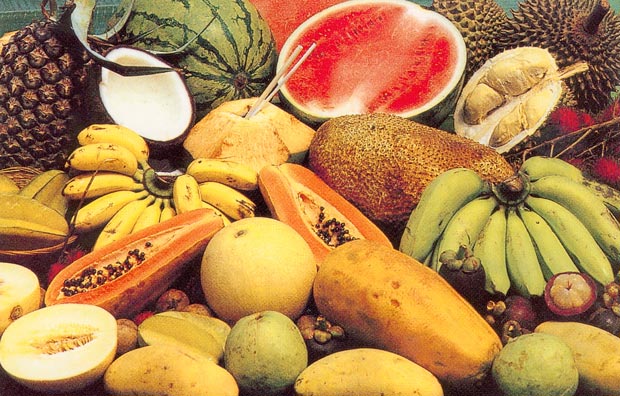 Averrhoa Carambola
Averrhoa CarambolaSynonyms : Carambole (French), Carambola (Spanish), Ma Fueng (Thaïland), Fuang (Laos), Khe (Vietnam), Belimbing (Malaysia)
Origin : The origin of the fruitis unknown, but it is probably native to Malaysia, Indonesia and India. Some people claim that it is originated of Moluccas.
Area of Culture : Despite its Asiatic origin, the fruit spreads out in the world. It is domesticated in the American tropics (Hawaï, Florida, Brazil..), in Australia. Its commercial production now occurs throughout tropical regions of the world and it is exported in Europe. Malaysia is the global leader of the star fruit production in the world.
 Flowers appear in groups at the pit between the leaves and the stem or at the branch apex. They are of pink colour. The blooming begins between November and December and the flowers follow one another until May.
Flowers appear in groups at the pit between the leaves and the stem or at the branch apex. They are of pink colour. The blooming begins between November and December and the flowers follow one another until May.

 The fruit is composed of 5 to 6 salient fins. The star shaped cross section gives to the Carambola its common name of Star fruit as well as it colour : translucent yellow.
The fruit is composed of 5 to 6 salient fins. The star shaped cross section gives to the Carambola its common name of Star fruit as well as it colour : translucent yellow.When you cut the fruit in slices, you can have much as star shaped slices as you want to.
The light-brown seeds are flattened and not numerous.
Climate conditions : The star fruit is a tropical and subtropical fruit. The Star fruit is best grown in warm regions from sea level to 2000 feet high. The fruit stops growing below temperatures of 55-60F and older trees can be killed when they are exposed a long time to temperatures below 28F. The fuit needs to be protected from extreme cold. However, older trees are more tolerant to frost.
The Star fruit needs also a shaded place at the beginning of its growth.
Cultural method : The Star fruit prefers full sun but it also requires enough humidity (rainfall). It does not have a preference in the type of soils (quality) but it requires a good drainage.
 The Carambolas need to be planted at least 20 feet far away from each other. You have to fertilize the plants four to five times a year and to give regular and moderate amount of water throughout the year. The fruiting period is situated during the months of June, July and August but in some regions of the world, you can have a n all year fruitung period. The first fruits appear at 4 to 5 years of age.
The Carambolas need to be planted at least 20 feet far away from each other. You have to fertilize the plants four to five times a year and to give regular and moderate amount of water throughout the year. The fruiting period is situated during the months of June, July and August but in some regions of the world, you can have a n all year fruitung period. The first fruits appear at 4 to 5 years of age.A Carambola is ripe when the fruit shows colours of yellow with a lightshade of green. At the contrary, an unripe fruit is green and an overripe fruit is yellow with brown spots on it.
 Uses : Fruits are generally eaten raw, but occasionally they can be used in desserts or juices. The best way to consume a Carambola, it is when it is ripe. The fruit is entirely an edible fruit, incluiding the skin.
Uses : Fruits are generally eaten raw, but occasionally they can be used in desserts or juices. The best way to consume a Carambola, it is when it is ripe. The fruit is entirely an edible fruit, incluiding the skin. Because of the fruit star shape, the fruit is also used as an adornment.


